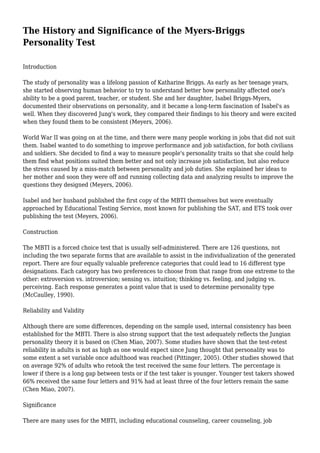
The History and Significance of the Myers-Briggs Personality Test
- 1. The History and Significance of the Myers-Briggs Personality Test Introduction The study of personality was a lifelong passion of Katharine Briggs. As early as her teenage years, she started observing human behavior to try to understand better how personality affected one's ability to be a good parent, teacher, or student. She and her daughter, Isabel Briggs-Myers, documented their observations on personality, and it became a long-term fascination of Isabel's as well. When they discovered Jung's work, they compared their findings to his theory and were excited when they found them to be consistent (Meyers, 2006). World War II was going on at the time, and there were many people working in jobs that did not suit them. Isabel wanted to do something to improve performance and job satisfaction, for both civilians and soldiers. She decided to find a way to measure people's personality traits so that she could help them find what positions suited them better and not only increase job satisfaction, but also reduce the stress caused by a miss-match between personality and job duties. She explained her ideas to her mother and soon they were off and running collecting data and analyzing results to improve the questions they designed (Meyers, 2006). Isabel and her husband published the first copy of the MBTI themselves but were eventually approached by Educational Testing Service, most known for publishing the SAT, and ETS took over publishing the test (Meyers, 2006). Construction The MBTI is a forced choice test that is usually self-administered. There are 126 questions, not including the two separate forms that are available to assist in the individualization of the generated report. There are four equally valuable preference categories that could lead to 16 different type designations. Each category has two preferences to choose from that range from one extreme to the other: extroversion vs. introversion; sensing vs. intuition; thinking vs. feeling, and judging vs. perceiving. Each response generates a point value that is used to determine personality type (McCaulley, 1990). Reliability and Validity Although there are some differences, depending on the sample used, internal consistency has been established for the MBTI. There is also strong support that the test adequately reflects the Jungian personality theory it is based on (Chen Miao, 2007). Some studies have shown that the test-retest reliability in adults is not as high as one would expect since Jung thought that personality was to some extent a set variable once adulthood was reached (Pittinger, 2005). Other studies showed that on average 92% of adults who retook the test received the same four letters. The percentage is lower if there is a long gap between tests or if the test taker is younger. Younger test takers showed 66% received the same four letters and 91% had at least three of the four letters remain the same (Chen Miao, 2007). Significance There are many uses for the MBTI, including educational counseling, career counseling, job
- 2. placement, team building, and personal development. A better understanding of personality types can help improve relationships as it allows one to accept others as they are or at least better understand why they act the way they do. It helps supervisors identify strengths and weaknesses in their employees so they can do a better job with employee placement, and can reduce conflict in the workplace allowing a more productive and positive working environment to develop. It also provides an outline to develop training programs (Allen, 1994). Conclusion Although it started out as a simple idea from a mother and daughter interested in watching people, the Myers-Briggs Type Indicator soon became one of the most used personality tests available (Chen Miao, 2007). Many well-known companies, including Hallmark Cards, have used the MMTI for many years not only to assist them with hiring decisions but also as a basis for developing strategies for change and developing a strong team that can communicate effectively with employees of all personality types (Overbo, 2010). Although not everyone involved in psychology is an enthusiastic supporter of the MMTI, there are many who are, myself included. References Allen, J. (1994). Using the Myers Briggs Type Indicator -- part of the solution? British Journal Of Nursing, 3(9), 473. Chen, J., Miao, D. (2007). Introduction to the Myers-Briggs Type Indicator. US-China Education Review, 4(3), 44-53. McCaulley, M. H., (1990). The Myers-Briggs Type Indicator: A measure for individuals and groups. Measurement and Evaluation in Counseling and Development, 22(4), 181-195. Meyers, K., (2006). An Extended History of the Myers-Briggs Type Indicator® Instrument. Retrieved on August 13, 2012 from http://www.mbtitoday.org/downloads/An-Extended-History-of-the-MBTI.pdf Overbo, J. (2010). Using Myers-Briggs Personality Type to Create a Culture Adapted to the New Century. T+D, 64(2), 70. Paul, A. M. (2004). The Cult of Personality: How Personality the myers briggs personality test Tests Are Leading Us to Miseducate Our Children, Mismanage Our Companies, and Misunderstand Ourselves. New York, New York: Free Press. Pittinger, D. J. (2005). Cautionary comments regarding the Myers-Briggs Type Indicator. Consulting Psychology Journal: Practice and Research, 57(3), 210-221. doi:10.1037/1065- 9293.57.3.210